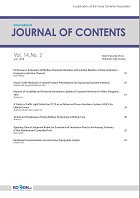- 권한신청
- P-ISSN1738-6764
- E-ISSN2093-7504
- KCI
 ISSN : 1738-6764
ISSN : 1738-6764
Reticence and Communication Preferences in the Classroom: Comparing “E-mail” and “Face-to-face” Interactions
신동희 (성균관대학교)
이충근 (Indiana University)
Abstract
This study examines underlying factors that influence undergraduate students’ willingness to enhance communication with theirinstructor by comparing the frequency of e-mail and face-to-face interaction between students and instructors. Data was collectedthrough a survey of 322 undergraduate journalism students at a large Midwestern university. The findings showed that the morepassive students were in expressing their opinion during the class, the less likely they were to send e-mails to their instructor (Coef. =-0.180, p < .01) or to communicate with their instructor face-to-face (Coef. = -0.262, p < .01). The findings also showed that themore students described their personality as “shy,” the less likely they were to e-mail their instructor (Coef. = -0.157, p < .05) orcommunicate with their instructor face-to-face (Coef. = -0.210, p < .01). It is noteworthy that the degrees of both passivity andshyness had a more negative effect on the probability of face-to-face interaction than they did on email interaction. In summary, emailusage follows similar broader patterns of social interaction, rather than introducing a different trend in communication. Thisfinding implies that the importance of e-mail should not be exaggerated as a communication tool for reticent students.
- keywords
- Personality, Communication Skills, Internet, E-mail, Classroom
- 다운로드 수
- 조회수
- 0KCI 피인용수
- 0WOS 피인용수

